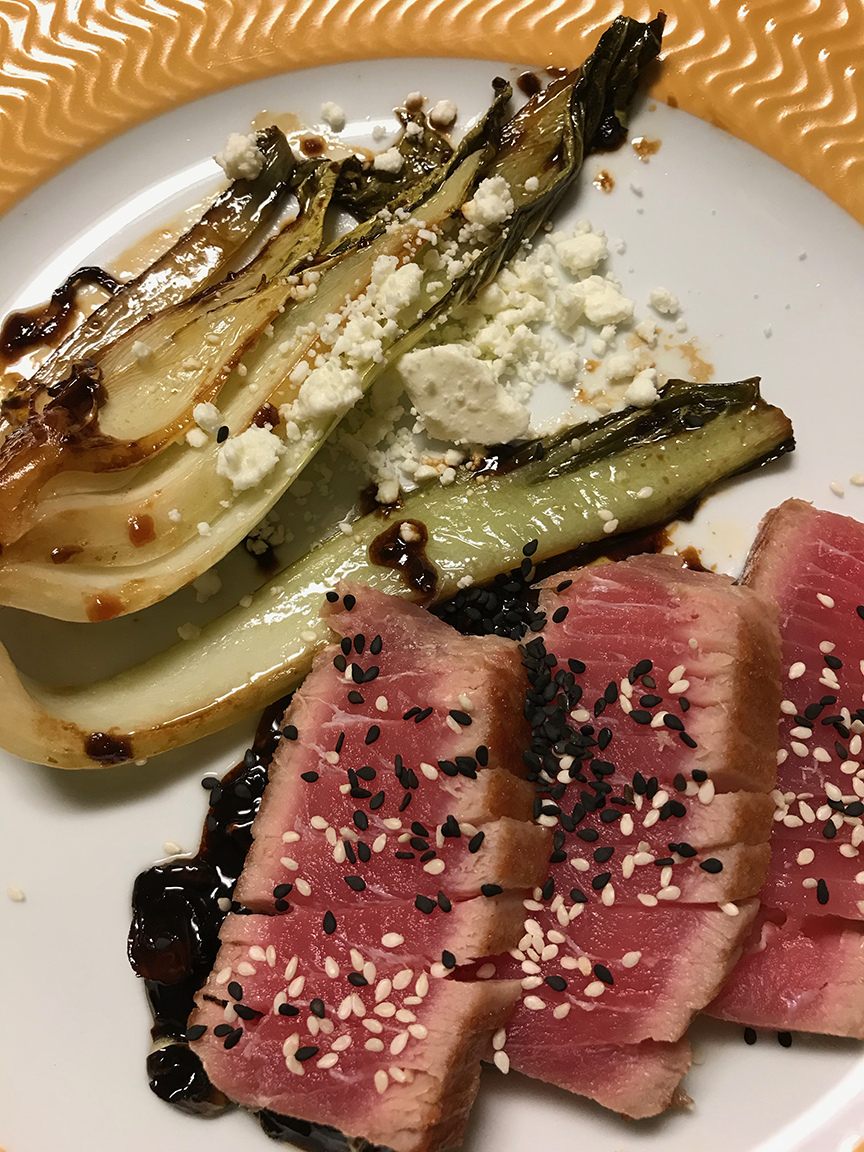
Bok choy with feta and seared tuna. January has passed and already I have broken my New Year’s resolution to prepare only healthy meals. I was tempted the other day by a fondue; a Swiss cheese fondue that eyed me at the grocery store, flaunting its red package dotted with small white crosses. It had the flair of a Swiss national flag!
Being Swiss, fondue represents for me traditional comfort food and has always been a wintertime staple. The dish is unctuous and is accompanied by traditional French bread or yellow new potatoes, the latter offering such a nice buttery flavor especially when dipped in cheese and sprinkled with freshly ground black pepper.
For fondue to be authentic, it must be cooked in a traditional caquelon (an earthenware casserole) and enjoyed with side dishes such as salami or cured meat, cornichon pickles and pearl onions. One rarely eats a fondue alone as the dish is foremost about conviviality among family and friends at home, or even better in a chalet restaurant nestled in one of the famous alpine ski resorts.

I am particularly fond of the Fondue Fribourgeois (affectionally called moitié- moitié) that traces its origin to the French speaking canton of Fribourg and is prepared with two famous cheeses: Vacherin and Gruyère. The latter being both a region and the name one of the quaintest 13th century medieval villages in Switzerland—“Gruyères”—where I spent my boyhood at boarding school. In fact, when we think of a Swiss fondue, moitié-moitié represents the staple fondue for tourism and marketing (above images).
As I have been unable to purchase Vacherin cheese in the United States, I am well aware of its substitute Swiss regional cheeses such as Appenzell, Emmental, or Sbrinz. But I have my bias when it comes to fondue, and as good as these alternatives sound, I have settled on a ready-made fondue that lives up to my childhood memories and eating my first fondue. It is delicious and, for me, justifies a small broken promise.
However, post fondue and again looking for healthier alternatives that bring equal happiness to my palate with far fewer calories, I recalled an amazing southern dish at Jonathan at Gratz Park, a local restaurant in Lexington, Kentucky. Eaten years ago, the meal consisted of seared tuna with bok choy and grilled polenta. Fond memories made me want to replicate this menu and off I drove to my nearby grocery store.

I found a beautiful thick red tuna steak and a medium sized organic Shanghai baby bok choy (the leaves are smaller and do not resemble those of Swiss Chard like other types of bok choy do). Although I opted to not prepare polenta, the dish, may I say, looked great and was truly exceptional (below image).
How to cook the meal when I had only memories to go by? I turned to the web and discovered a recipe that approximated the flavor I was looking for, but the ingredients omitted the quantities and fell short on the sweetness that I remember relishing at Jonathan’s. Bok choy is part of the Chinese cabbage family, and knowing that I would need to add flavor to the vegetable, I was eager to interpret the on-line recipe that called for cooking the vegetable merely with garlic, shallots, a dash of soy sauce and sesame oil.
I opted to add an Amai Sauce that I normally use to prepare a wonderful noodle dish from the cookbook by the famed British Wagamama restaurant that built its reputation on “Asian food inspired by the flavors of Japan.” I also added grilled shallots and some crumbled Greek feta to give a tangy and salty touch to the overall dish. Voila, I had created my first fusion of Asian and Mediterranean flavors.

I seared the tuna steak rapidly in a non-stick pan with a drizzle of vegetable oil to not flavor the fish. I enjoy tuna rare to medium-rare and after cooking each side no longer than a couple of minutes, I sliced the tuna, added some black and white sesame seeds, plated the bok choy with the Amai sauce and some sprinkles of Feta cheese. I felt that I was at a fancy restaurant, in fact I was back at Jonathan at Gratz Park with a touch of intuition and surprised at how easy the dish was to prepare.Would you like to replicate this dish at home? It’s simple and does not need much skill: Seared tuna steaks and Garlic Bok Choy
NOTE: Bok choy is a wonderful vegetable to accompany other proteins such as chicken or salmon.